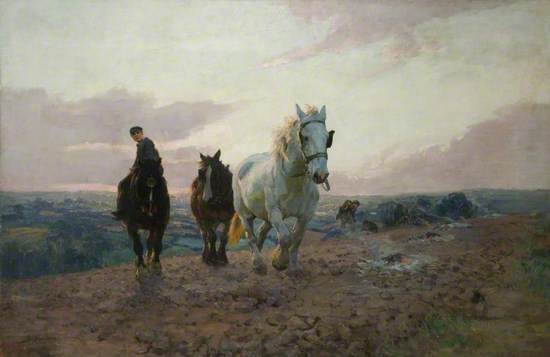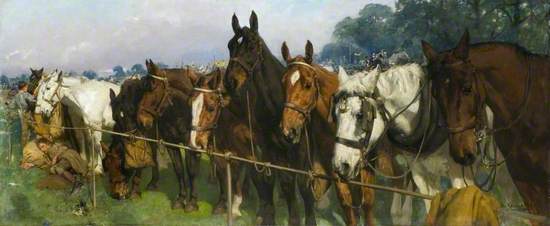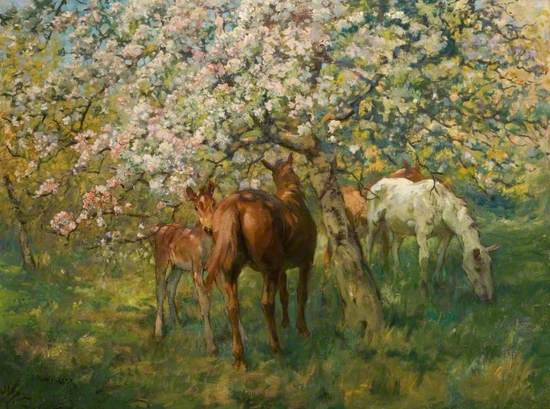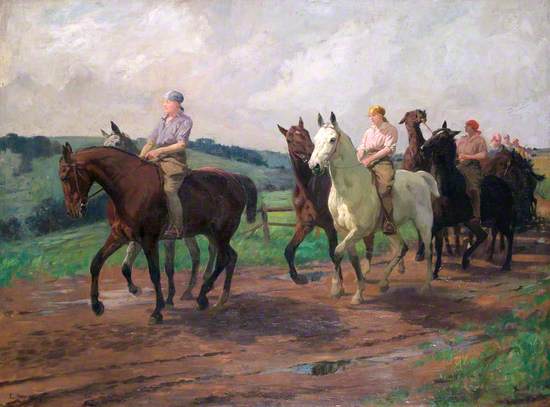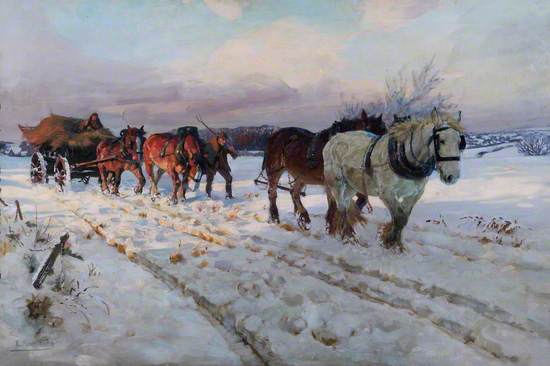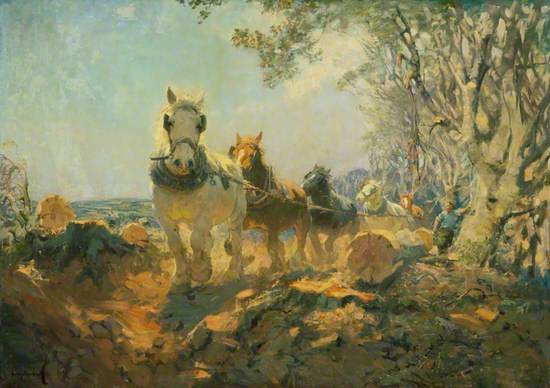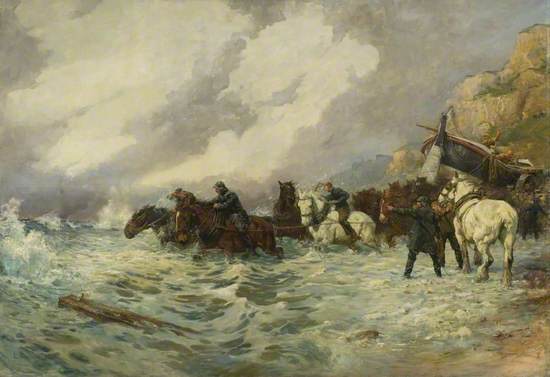Lucy Kemp-Welch (1869-1958) was one of this country’s most important equine artists.
Born in Bournemouth, she received informal lessons from local artist Arthur Davis (1847-1895) and formal training from Sir Hubert von Herkomer (1849–1914) at his school in Bushey, which she later took over.
The first women elected to the Royal Society of British Artists, there were hopes that she might also be the first woman elected to the Royal Academy since 1768 but sadly it never happened.
Touring to the National Horse Racing Museum, this exhibition is the first for 20 years devoted to Lucy Kemp-Welch. Guest curator David Haycock has brought together public and private loans with archive material to restore her reputation and significance.
Toilers
Horses were an essential part of life in late 19th and early 20th century England, as draft animals and for transport. This early painting portrays three horses that would have spent their days pulling cabs in and around Bournemouth. Lucy always preferred painting working horses to thoroughbreds. She believed they displayed more character and individuality.
Lucy Elizabeth Kemp-Welch (1869–1958)
Oil on wood
H 17 x W 24 cm
Russell-Cotes Art Gallery & Museum
Study for 'Gypsy Horse Drovers'
Lucy had been at Herkomer’s art school little more than a term when she saw a group of Romani men driving horses down the muddy road through Bushey. Realizing at once that it would make an excellent subject for a painting, she rushed from her house with the nearest object to hand – the lid of her paint box. She used it make what she called this ‘lightening sketch of the scene’ in oil.
Lucy Elizabeth Kemp-Welch (1869–1958)
Oil on panel
H 19 x W 33 cm
Russell-Cotes Art Gallery & Museum
Gypsy Horse Drovers
This painting was so large it did not fit into the room Lucy was using as her studio, and one end poked out of the window. Professor Herkomer was astonished when he first saw it. It seemed incredible a young, inexperienced student – and a tiny woman at that – could have painted such a vast and accomplished picture.
Lucy was delighted by Herkomer’s response. She later wrote that ever afterwards ‘he never ceased to be the kindest and sincerest critic and guide, that ever a young painter had.’ It was the first painting she exhibited at the Royal Academy, in 1895. The painting sold before the exhibition opened and the copyright bought by the Fine Art Society, success beyond Lucy’s wildest dreams.
Lucy Elizabeth Kemp-Welch (1869–1958)
Oil on canvas
H 120 x W 242.5 cm
Russell-Cotes Art Gallery & Museum
Foam Horses
Inspired by the sea off Parkstone, Dorset, this early work was shown at the Royal Academy’s Summer Exhibition in 1896. Between 1850 and 1900 the number of works exhibited at the RA by female artists increased almost ten fold. Though they were still a minority, more women were becoming professional painters. Recognised as one of the leading female artists of the day, Lucy’s name frequently appeared in the press – from gossip columns to exhibition reviews.
Lucy Elizabeth Kemp-Welch (1869–1958)
Oil on canvas
H 49.2 x W 90.5 cm
Russell-Cotes Art Gallery & Museum
Burnt Out Fires
Lucy’s sense of light, colour and design were exceptional. All three skills are revealed to the full in this painting of horses heading home from a day’s labour as dusk begins to fall. Each autumn farmers would burn the stubble in their fields. A practice once frequently encountered in the English countryside, it was banned in 1993.
Lucy Elizabeth Kemp-Welch (1869–1958)
Oil on canvas
H 122 x W 183 cm
Bushey Museum and Art Gallery
The Morning
Following the outbreak of the Second Boer War in 1899, Lucy painted a number of imagined pictures inspired by contemporary events in South Africa. This work was prominently positioned at the Royal Academy’s Summer Exhibition in 1902, and Lucy recorded in her diary the enthusiasm and praise of some of the Academicians. However, other critics (including Herkomer) felt she should stick to working directly from real life – advice she would heed hereafter.
Lucy Elizabeth Kemp-Welch (1869–1958)
Oil on canvas
H 151 x W 120 cm
Bushey Museum and Art Gallery
Mixed Company at a Race Meeting
As this painting reveals, each horse was an individual to Lucy, their personality and peculiarities carefully portrayed. Groups of horses together like this particularly interested her: ‘I love their rows of kind faces as they stand tied,’ she later wrote. ‘They are all known by name, and spoken of as friends.’ Such sentiments were a key feature of her success as an artist.
Lucy Elizabeth Kemp-Welch (1869–1958)
Oil on canvas
H 75.5 x W 182.5 cm
Bushey Museum and Art Gallery
1911

Study for 'The Riders'
In 1904 Lucy befriended Lieutenant-General Robert Baden-Powell (1857–1941), hero of the Boer War and founder of the Scouting movement. His horse, Black Prince, would appear in many of her works, including 'The Riders' and her illustrations for 'Black Beauty'. The finished painting (now in Sheffield Museum) was inspired by lines from 'The Last Ride Together', a poem by Robert Browning (1812–1889). It is one of the artist’s most enigmatically romantic paintings. Lucy had at least two close friendships with young artists in the early 1900s. Tragically, both men died young, leaving her deeply upset.
The Years at the Spring
Lucy and her sister Edith kept horses and chickens in the orchard behind their house, and Lucy had a studio built there with glass walls, so she could paint in all weathers with natural light. Studio and orchard were the location for many paintings, including this one. The glorious apple blossom complements the white and chestnut coats of the horses – a beautiful example of the artist’s skill as a colourist, and the keen sense of design displayed in all her work.
Lucy Elizabeth Kemp-Welch (1869–1958)
Oil on canvas
H 78 x W 99 cm
Bushey Museum and Art Gallery
The Ladies' Army Remount Depot, Russley Park, Wiltshire, 1918
Horses were vital to British Army during the First World War. Aside from use by the cavalry, horses hauled every sort of supply imaginable as well as artillery pieces and ambulances. They even helped lay telephone cables via specialist wagons.
Many of the horses acquired by the British Army came from North America, and were trained for military service at remount depots in England. Russley Park, Wiltshire, was one of a handful staffed and run entirely by women. Unsurprisingly, the inspectors who periodically visited the depots stated ‘they have never known horses to be so well attended to by men’. In 1919 the Imperial War Museum commissioned Lucy to paint an official record of the depot before it returned to peacetime activities.
Lucy Elizabeth Kemp-Welch (1869–1958)
Oil on canvas
H 111.7 x W 148.3 cm
IWM (Imperial War Museums)
Winter's White Silence
Lucy often paired a grey with darker horses as a central feature of her compositions. ‘It is always pleasant too and a great advantage to have a white horse in a picture,’ she explained, ‘as it gives light and brilliancy to the whole thing’. The effect works particularly well in this bright, snow-focused painting, which also reveals the loosening of Lucy’s technique under the influence of Impressionism in the years immediately after the First World War.
Lucy Elizabeth Kemp-Welch (1869–1958)
Oil on canvas
H 125 x W 181.5 cm
Leamington Spa Art Gallery & Museum
Timber Run in the Welsh Hills
Though small of stature and modest of manner, Lucy Kemp-Welch did not behave in the way generally expected of Victorian or Edwardian middle-class women. Always a keen rider, she helped round up semi-wild ponies in the New Forest, and drove teams of powerful horses hauling heavy timber. It was this energy and activity that brought such life and truth to her work. Her paintings were rarely sentimental.
Lucy Elizabeth Kemp-Welch (1869–1958)
Oil on canvas
H 110.8 x W 155.5 cm
Southampton City Art Gallery
1933

The Sport of Imperial Rome – The Start of the Chariot Race
In what may have been only two trips abroad, in 1914 Lucy visited Italy. This large drawing, which fully reveals her extraordinary skill with pastels, might have been inspired by that visit. It was exhibited at an exhibition of the Pastel Society held in Bournemouth in 1943, and purchased by the Russell-Cotes Art Gallery directly from the artist. She expressed her delight ‘that this picture will stay in my native place.’
Gypsy Horses or Autumn Gold
Many artists and writers had a romantic fascination with Romani life in this period. ‘We often meet with this pleasant scene of a Gypsy camp beside a country road,’ Lucy noted, ‘or, more often, in some quiet byway, where the smoke of the camp fire makes a blue mist amongst the trees and where the horses may wander free, herded only by the younger members of the family ... And the sight of it stirs in the heart of many a quiet, law-abiding man, the long forgotten thrill of the wild when primitive men led adventurous lives in the morning of the world.’
Lucy Elizabeth Kemp-Welch (1869–1958)
Oil on canvas
H 73 x W 93.5 cm
Russell-Cotes Art Gallery & Museum
The Call
Lucy’s young friend, the painter Edward Seago (1910–1974), suggested this subject after he witnessed the launch of the Brook lifeboat on the Isle of Wight. By the time Lucy came to paint it official horse-drawn launches had ceased. It is thus based on an amalgam of the Brook, Worthing and Newhaven boats. Painted when she was in her late 60s with failing eyesight, this dramatic, large-scale painting would be the last of her major works. It was selected but not hung at the Royal Academy in 1939.
Lucy Elizabeth Kemp-Welch (1869–1958)
Oil on canvas
H 168 x W 242 cm
Bushey Museum and Art Gallery
Explore artists in this Curation
-
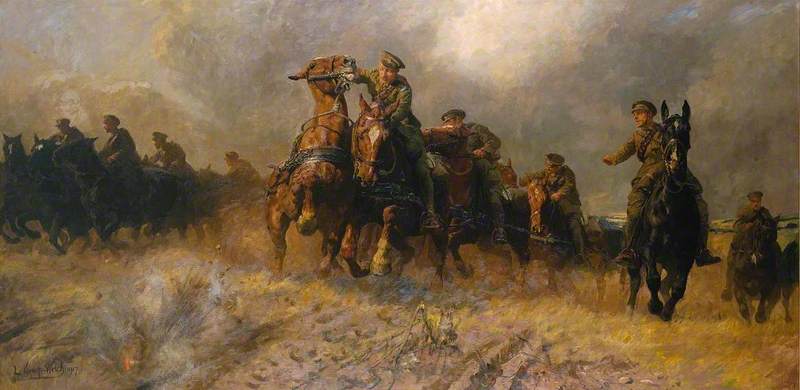
© David Messum. Image credit: Tate
Lucy Elizabeth Kemp-Welch (186…
